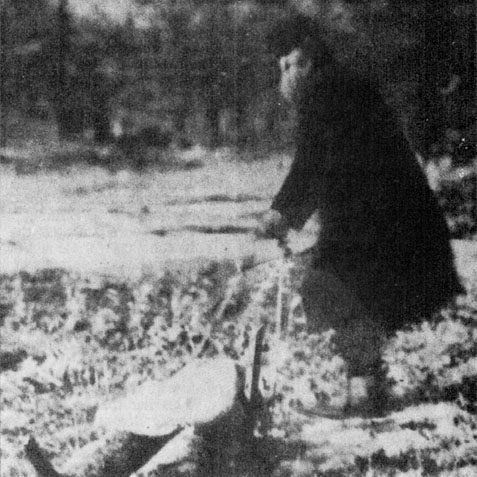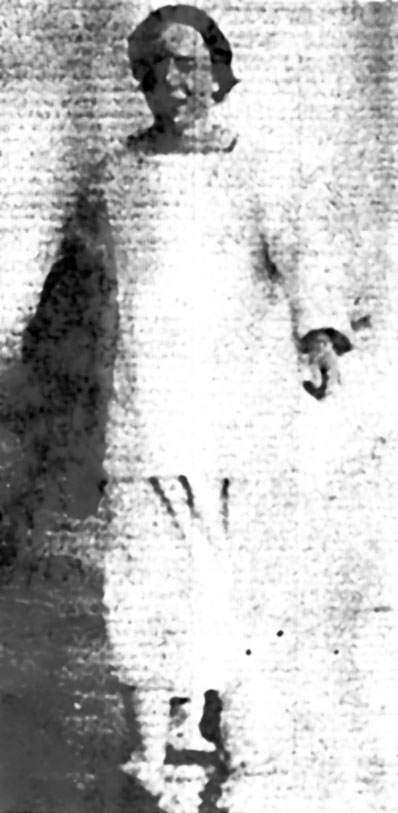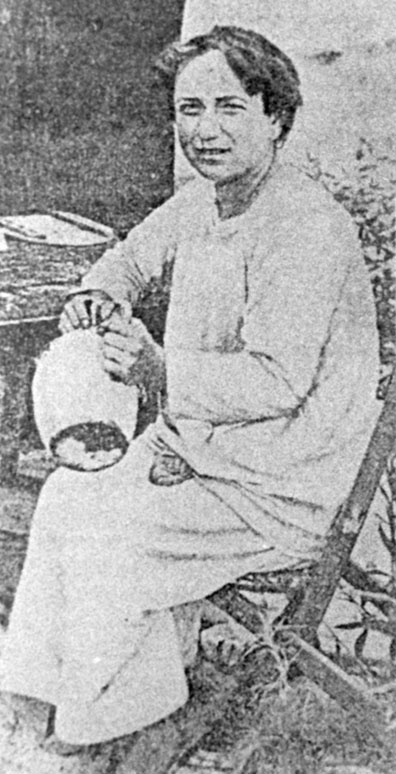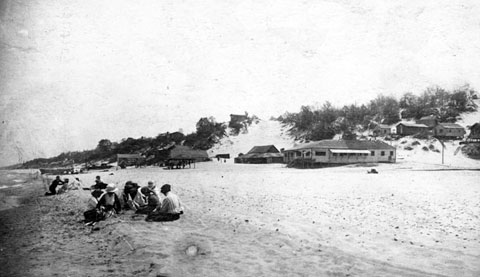
Diana of the Dunes
Cleaving the water like a milk white dolphin came a mermaid. She made the
shallows, rose up out of the water, then like a fabled nymph, flitted off into the
shadows.94
—the Lake County Times, 1916
For four years Diana of the Dunes has been the most interesting character in all
northern Indiana. As a student she was very bright, a skillful typist, and fitted to
make a good living if she had chosen the ordinary way.95
—the Lake County Times, 1918
A flurry of newspaper stories first announced the presence of Alice Gray during the summer of 1916, nine months after she settled in the dunes. Although spare in background detail, these fledgling glimpses of Alice hit the newspapers with all the sensationalism reporters could muster. Accounts of a lonely nymph living in the wild sand hills thrilled readers in Chicago, throughout Indiana and northward into Michigan; even today, strong vestiges of these early, romantic portrayals remain in legendary stories of Alice.
Initially, her identity was a mystery. Newspapers printed their own guesses. They speculated on whether Alice was Miss Elizabeth Wilkins, a former University of Chicago instructor, or Miss Wilhelmina Wilkins (apparently unrelated), an heiress of Walla Walla, Washington, who had disappeared two years before.96 These women, and perhaps others who had gone missing from polite society, gained renewed attention in Alice’s story.
While a number of “hermits” had settled in the region over the years, Alice likely attracted such unprecedented attention because she was younger and female, an unconventional candidate for such a difficult existence. The others who came before her were whiskered old men with colorful stories, mostly loners who kept to themselves. Author and artist Earl H. Reed, a Chicagoan, often visited the dunes region, sketching and writing about such local inhabitants as Old Sipes, Happy Cal, Catfish John and Doc Looney. They, too, had given up on society for one reason or another. They were crusty, though, eking out a meager existence as if it were second nature. Alice, on the other hand, seemed refined, educated and a bit too spoiled to make a serious attempt at living in the dunes. Her brashness captured the spirit of the dunes, however, and apparently folks wanted to know how was she doing; was she going to make it? Reporters kept close tabs on her—at least in the beginning, then intermittently. That is, until an incident in the summer of 1922; one that would dramatically change the dynamic between Alice and the press.
The first reporters, the ones who announced Alice to the region in 1916, focused more on selling newspapers than recording the truth, so words like “recluse,” “nymph” and “mermaid” populated their writings. A short time later, thanks to the creative impulse of an unknown editor, Alice became Diana of the Dunes.

Dunes dweller George Blagge died in 1914. It is speculated that Alice Gray moved into his abandoned shack in 1915. This photo was reprinted in Margaret A. Larson’s Memoirs of Old Baileytown ‘Plus.’
Early on, however, newspapers also labeled Alice as the Mysterious Nymph of the Sand Dunes.97 The reference to “nymph” derived, at least in part, from her reported penchant for bathing naked in the lake. Her habit was discovered by fishermen who were content to keep their distance but who apparently relished spreading the word. Newspapers were tipped off to the story by a fisherman’s wife. On July 21, 1916, several rival reporters visited Alice, their accounts appearing in print the next day.
The Lake County Times, an Indiana newspaper, spiced up the story this way: “Twice daily, according to fishermen, the nymph of the dunes, whose name is not known, takes her plunge like a goddess of the wave.”98
Two days later, the same newspaper changed its tone: “Of course it’s all right to call her a beautiful nymph and tell of the gleam of her white glistening skin as she bathes like Venus in the waters and all that, but the fact remains that she’s 40 and brown as a berry and tolerably husky.”99
Alice was neither beautiful nor yet age forty. She was thirty-five, unconcerned with presentingastylishappearance and adamantly independent.

A photograph of Alice Gray published in the Chicago Sunday Herald on July 23, 1916, just after fishermen discovered her in the dunes.
Adding to her mystique, Alice confounded people by speaking intelligently and—especially with reporters—emotionally. While staunchly guarding her privacy on her own sandy ridge, Alice felt comfortable talking with folks when she walked into town, most of whom posed no threat to her. If anything, she was a curiosity. Both children and adults followed her into a local store or the library, just to catch a glimpse of the strange woman they had heard about from neighbors and newspapers.
Ironically, a Chicago reporter, one of the first to interview her, seemed cautious of the information Alice shared, and with good reason. She falsified her history—for the first time but certainly not the last. During the interview, Alice said she moved to the dunes because a specialist “blundered” in treating her eyes; she had no choice but to give up working. There is no evidence that she had problems with her vision. She also informed her interviewer that although her mail arrived addressed to “A.M. Gray,” the name was assuredly fictitious.
Underlying the reporter’s words is an observance that his subject’s temperament seemed shaky at best. The article described Alice alternately as a “nymph,” “recluse,” “young woman” and a “girl,” who was both “hostile” and “hysterical,” pacing back and forth on the beach as they talked. At the same time, Alice’s intelligence came through, despite any frenzied antics on her part. The reporter took some liberty in describing her background, using her supposed pseudonym cautiously by placing it in quotations:
“Miss Gray” is a young woman apparently of English descent. Judging from her conversation, she has a broad classical and general education. Her skin is brown and despite her assertions that she is living in the wild because of ill health, she has the appearance of one who never has been ill in her life....She is intensely temperamental. Angry moments were followed by laughter.100
The reporter concluded, as many others have since: “Altogether, the ‘nymph of the dunes’ is a mysterious person.”
The Lake County Times news story, running under the headline “Nymph Is Plump and Forty,” took a more pronounced slant regarding her mental capacity:
From a distance they saw the lonely inhabitant. Her black hair was bobbed and she wore a black dress....She can converse fluently on any subject and her speech indicates past refinement and culture until an unsteady brain led her into her odd illusions. She is the queen of the hills, she claims. Her name she has never mentioned. She takes her daily dips in the lake and appears happy. Occasionally she walks to Porter and buys supplies, and her money seems to be plentiful.101
Alice’s story became well known so quickly that even in passing reference she became noteworthy in Chicago:
The “Nymph of the Dunes” was outnymphed yesterday. Three small boys created a stir on the University of Chicago campus when, clad in the scantiest of garments, they plunged into the Hull court fountain in full view of an admiring throng.102
At the same time Alice’s existence was announced, newspapers were busy covering the push by Chicago naturalists to preserve the dunes region. A Gary, Indiana headline voiced suspicion about the timing of her discovery: “Is This a Scheme to Attract People to Dune Region?”103
And then there was a letter-to-the-editor writer who suggested that Alice be put in charge of the proposed national park. “I haven’t the slightest idea who she is, but I feel she would make good,” he wrote.104
A newspaper writer responded:
Even though Mr. Damon hasn’t “any idea who she is,” the rest of the world knows by this time that Diana of the Dunes is Miss Alice Gray, who lives in her hut by the lake and takes her morning plunge without reference to beach rules in the matter of clothing. And if the dunes are to become a national park, she is already in charge—with an automatic gun to back her authority.105
Alice hid for a while in the sand hills the first day reporters arrived. Realizing they did not intend to give up, however, she appeared before them, one by one. They heaved thick questions, like wet sand clots, aimed directly at her sensibilities, sending Alice into another whirlwind of doubts about how she was leading her life. Several articles, all of them printed July 26, 1916, suggest that after notoriety arrived, she faltered, reconsidering her decision to stay in the dunes.
Under the headline “Nymph O’ Dunes Visits Chicago,” published in the Lake County Times, the writer trumpets his discovery of her in the big city, dining in the College Inn, a trendy restaurant and up-and-coming jazz venue located in the celebrated Hotel Sherman at West Randolph and North Clark Streets.
With the public revelation about Alice’s castaway life only four days old, already reporters recognized her outside the realm of her remote sand hills, or so the article maintained.
After sight-seeing Miss Gray dined in the College Inn, and then watched the dancers whirling about, her eyes bright with interest and her lips half-parted in amazement and amusement.
She soon was recognized and chatted freely with newspaper reporters, who were well-represented....
“Really, I should love to dance, but I don’t know how,” she said in response to an invitation. “I just want to watch the others. Am I going back to live on the dunes? Really, I don’t know. Oh, Solitude—”106
One newspaper invited Alice to write her own account of her visit back to Chicago. She visited downtown Chicago, taking in her first motion picture and wandering along the city’s newest attraction, Municipal Pier (known since 1927 as Navy Pier). Of the pier, she wrote: “It takes perhaps an hour in the street car for the average Chicagoan to get there. But your millions for this, and not a quarter of a million to save the dunes from being Garyized, with the dunes now only an hour away by train. Is this forward-thinking, Chicago?”107
In response to the question of whether she would leave the dunes and move back to the city, Alice wrote, “I love the great silent darkness up there; the silence that lives in the noise of winds and water, the darkness that finds itself in the fleeting, eternal waves of those reaches of waste sand; the only reality of life for me is there.”108
A second story, borrowed from the Michigan City Dispatch and reprinted by the Gary Evening Post, originates from the dunes, although whether Alice spoke directly to reporters is unclear. The headline summed up, rather matter-of-factly, public sentiment regarding her departure from Chicago and the gravity of her presence in the dunes: “Diana of the Dunes May Go Back to Life.”
The sand dunes...are to lose the young woman hermit who was discovered Friday living the simple life in a hut near the shore of Lake Michigan. The newspaper publicity has resulted in daily pilgrimages being made to her home, to her great annoyance, and she now threatens to migrate to some other out of the way place, where she can be alone.109
A third headline, “‘Diana of the Dunes’ Flees Her Habitation,” ran above a brief paragraph on page one in the Porter County Vidette. Someone spotted Alice at the train station, on her way out of the dunes. “‘Diana of the Dunes’ left her habitation yesterday and today is very likely back in the rush of Chicago. The woman took a South Shore car at Oak Hill yesterday morning and seemed very busy on a manuscript.”110
(Regarding Alice’s penchant for working on manuscripts, this tantalizing image pops up throughout her story, but none of the manuscripts has been found.)
From the reporting, it seems that Alice explored two options: retreat to Chicago, with all the workday frustrations of city living she had left behind, or move to another isolated location along Lake Michigan.
However conflicted, Alice did neither, exercising instead a third option: she asserted her right to remain in the dunes and occupy the same shack, swim along the same shoreline and follow the same paths into town. Certainly, she had a clue that the ensuing publicity would be relentless, although she must have hoped, even assumed, that it would die down after a while. Why else would she stay?

A photograph of Alice Gray published in the Indianapolis Star on February 12, 1925.
It is possible that Alice stayed in the dunes region where she first settled because she had made some friends there, folks she relied on—for blueberries (which she hated to pick herself), for bread and salt, for brief moments over coffee in a warm kitchen, for books and for sturdier shelter when temperatures became unbearable. This small circle of acquaintances helped her endure a winter largely under her own care; they were an important group, and her survival was a difficult feat. It might have been too outrageous a thought to simply walk away from such important connections—such gifts.

A postcard of Waverly Beach in Chesterton, Indiana, in the early 1900s. The area is now known as Indiana Dunes State Park. Courtesy of the author.
But her love for the dunes and the freedom the region provided for Alice were powerful influences, too. On December 8, 1915, she wrote, “If I had not been desperate I should not have thought of coming up here; and how wonderful, how unspeakably healing and sanctifying it has been living in all this beauty and this keenly vital air and in the blessed solitude.”111
Besides, by the time the gossip chain and newspaper operations snagged Alice’s story, it was summertime. The stoic, glistening sand hills, the deep and ever-changing hues and moods of Lake Michigan, the lush woods—all are beautiful in mid-July. Who would trade such a vista, such a glorious horizon—one made more stunning with each new day of mesmerizing clouds, broad sunsets or fast-moving storm fronts—for crowded streets and the politics of a working life in the city, especially if she had a choice to remain? Alice had beaten back winter; it was time to welcome the warmer days ahead and claim those, too.